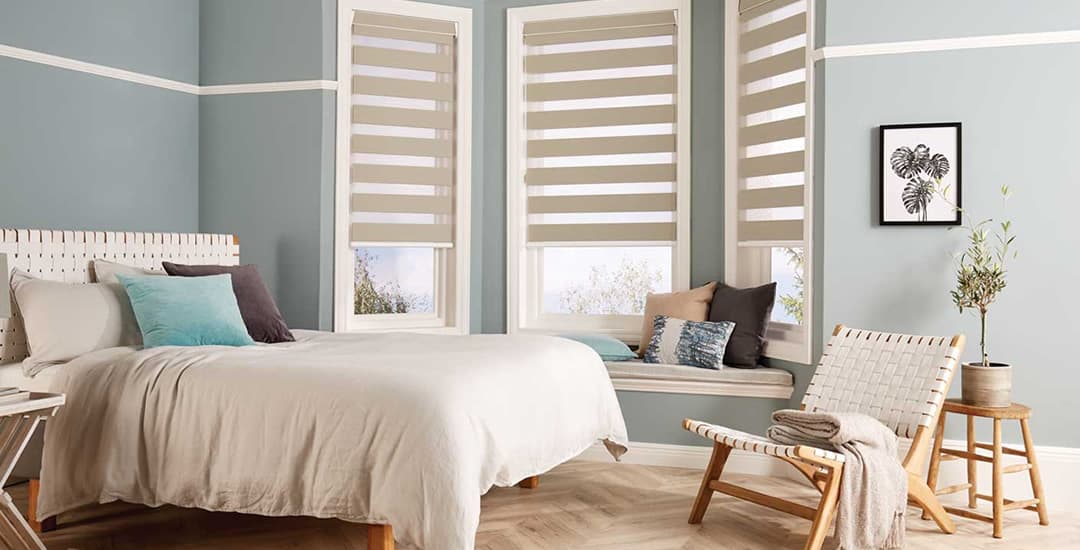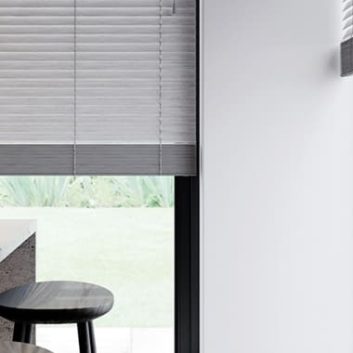
Day and night blinds or zebra blinds are something of the new kid on the block (or rather, the block’s windows) in the UK. Day night blinds for sale aren’t offered by all blinds retailers just yet (we’ve got loads though if you want one) which means you may never have seen one in action and so, might not really get what they do or how they do it.
This blog post is designed to take the pressure off my email inbox in terms of the volume of “how do day and night blinds work?” Questions I’ve been getting of late, by telling you how to operate a day night blind and also the various different effects you can achieve when you do.
So, how does a day and night blind work? Pull the side chain and the blind moves up or down, and at the same time, magic happens in terms of the alignment of the stripes. Read on and I’ll tell you more about how to use a day and night blind to either block light entirely, or filter light and improve your privacy while still allowing you to enjoy the view of outside.
How do day night blinds work operationally?
How do you make a day night blind go up and down? With a side control chain just like a regular roller blind, which you pull in one direction or the other to move the fabric.
Talking of chains, just for the record day and night blinds meet all of the relevant UK child safety legislation too, as long as you fit them according to our directions. Their control chains have a safety p-clip attached which fixes them to the wall as well just in case, to ensure they’re not dangerous to even the most err, “adventurous” of kids.
They can be rolled up or down into any position of your choosing, from fully open so your window is fully exposed, to fully closed; and when in the closed or partially closed position, the alignment of the blind’s stripes (which I will cover next) dictates the effect achieved.
How does a day and night blind work in terms of adjusting the stripes?
This is by no means obvious if you’ve never seen or had a go with day and night blinds! UK interiors sites and magazines have only just started to really get day and night blinds on their radars at all, and a picture and a description isn’t ideal in terms of demonstrating how they work; but here’s my attempt at an explanation anyway:
Day night or zebra blind stripes align in different formations on the front and the back of the tube depending on the position you stop the chain in.
This is because day and night blind fabric goes around the tube in a continuous loop, running up both sides of it. The benefit of this is to give you pretty much the same range of options for light blocking versus filtering, and seeing out versus stopping passers-by from seeing in, as you get with blinds that have adjustable slats or louvres.
A zebra blind or day and night blind then, is functionally a bit like the results of a planned mating between a roller blind and a Venetian blind; all the benefits of hybrid vigour built in.
So how they work in terms of adjusting the stripes and the different effects that this creates and functions they serves?
As you adjust the blind’s control chain, the stripes on the front and the back of the blind slide or cross over each other. Where they’re all sitting when the music stops (ie., you leave the chain alone) dictates the effect you get.
- Align the solid or opaque stripes front and back into one continuous block, and you get full privacy from people outside, but also, you cannot see out. This achieves the same effect as fully closing a Venetian blind; or having a regular roller blind rolled all the way down. Blackout day and night blinds fully block the light when in this position, other day night blind fabrics result in a dim-out effect.
- Align the solid stripes and sheer stripes with their matching partner on the front and back of the blind, and you get the sharpest striped-looking effect; I like to call this Full Zebra. This is the position you’d leave the blind in if you wanted to get plenty of light to the room and be able to enjoy the view clearly; but also want to take the edge off what people outside can see happening inside unless they really press their noses to the glass.
- Skew the alignment of the front and back stripes to a degree so they’re partially crossing each other, and you can adjust how much light/external view you get, how much shade your room gets, and how hard your nosey neighbour will have to work to see what you’re having for lunch, to a very fine degree.
PS., If your “how do day and night blinds work” question still hasn’t been answered in a way you can understand or you have another query about what day and night blinds do and how they do it, my email inbox is still open.




